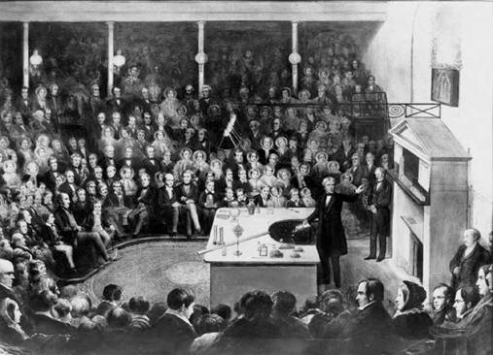This web page was produced as an assignment for Genetics 677, an undergraduate course at UW-Madison Spring 2009
How do we communicate science to the public?

The above picture is a public lecture given by Michael Faraday (credit for the picture to Joseph Steim of Brown University's website for a Chemistry course). While public lectures by renown scientists may not be as common as they were in the past, there are a lot of ways in which scientists attempt to communicate with the public. One of the more common ways this is accomplished is through popular press articles written by science journalists. Because a large amount of public funding is used for research in the U.S., it is important for the public to understand where this money is going and the benefits they receive. Science writers have a very different role and audience than scientists do and therefore the style of writing is also quite different. Below I briefly examine the effectiveness of the scientific article and popular press articles I have reviewed.
Scientific Article vs. Popular Press
Obviously, the audience reading a scientific article and a popular press article are different. However, I think both the scientific and popular articles that I have reviewed speak well to their readers. The popular press article focuses more heavily on what the experimental logic was and why it is important that they study had certain design elements. This makes a lot of sense because the general public is not nearly as affluent in reading a primary source paper and picking out details of the experimental design that confer a greater degree of validity to the results. By helping readers pick up on these points, the author does a great service both to the scientists and the general public by improving public perception of the science and the elegance and depth required for a well-designed study.
On the other hand, the scientific article focuses more heavily on results and data. Additionally, in the discussion, the authors talk more about what the results mean for further research. In a popular press article you might expect some speculation about what the results mean for potential therapies and other treatments, but a scientific article is not the place for such speculation. Both of these articles do a good job of identifying their audience and conveying information that is both salient and appropriate.
Email: [email protected]
Last Updated 5/13/09
Genetics 677 Homepage
